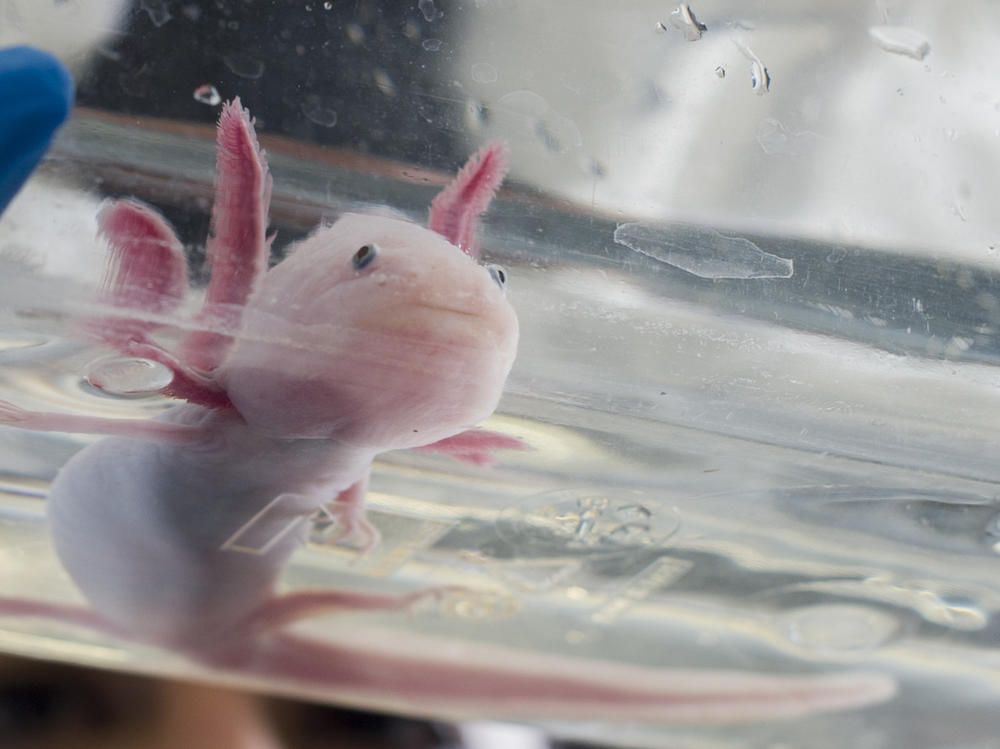Section Branding
Header Content
It seems like everyone wants an axolotl since the salamander was added to Minecraft
Primary Content
The axolotl, with its permanent grin and youthful-looking body, has captured hearts thanks to TikTok and the popular video game Minecraft, which added the salamander to its universe in 2021. More and more people have been getting them as pets.
"I would attribute about 90% of axolotls' popularity to Minecraft and TikTok, but mostly Minecraft," Jake Pak told NPR over email.
He says nearly every kid who comes to Axolotl Planet, the breeding and sanctuary company he co-owns, is there to see one in real life after learning about them from the game.
Children often ask for blue ones, which are the rarest in Minecraft, and are disappointed to find out that it's genetically impossible for the animal to be blue.
Eric Rasmussen, who owns The World of Wet Pets in Portland, Ore., says the store has carried axolotls for many years. It has been only in recent months that he has seen people's interest in them skyrocket.
"I mean, this year is pretty much the year that we can't keep them in stock," he told NPR over the phone. "And because demand is so high, the value of the doggone little things has gone through the roof."
He estimates that they're about twice the cost they were last year, and he expects prices to go up — especially since they've now become designer animals, with some having a modified protein that makes them glow fluorescent under a blue light.
Customers accidentally breeding them has been the most reliable source for axolotls for Seattle's The Fish Store, according to employee Cory Giess. He told NPR that the shop has struggled to get them from breeders and that most of the current stock is from a customer who accidentally bought two of the opposite sex.
Pak explains that there can be risks when a customer breeds axolotls, whether they intend to or not.
One concern is inbreeding. If someone doesn't know the bloodlines of their animals, there's a "very high chance" that offspring could carry fatal recessive genes, Pak explained. Right now, he said, eyeless axolotls are popping up in the industry as a result of inbreeding.
There's also the commitment it takes to care for these animals.
"Axolotls can lay over 1,000 eggs at a time, and if you do not have the space, time and knowledge required to care for the babies, then they will most likely all die prematurely or, as we are seeing with New Zealand, creating a crisis of abandoned axolotls," Pak said.
In New Zealand, axolotl owners have been relinquishing the creatures to pet shelters en masse. In a Facebook message to NPR, the pet store Scales, Feathers, Fins & Fur in Dunedin said it has around 2,000 of them in its care.
In an email to NPR, Blue Ridge Reptile Rescue (which sometimes cares for amphibians too) said that it can be quite difficult to rear the amphibian "by accident."
"Get eggs accidentally, sure, but they require special care for incubation, and you must breed and maintain special food for the hatchlings. No one does this by accident," it stated.
Some owners might be taking these steps without realizing the consequences of hatching hundreds of baby axolotls, and the rescue fears that people may be breeding them with the intent of selling them for easy money — and then getting stuck with them.
Giess urges customers to bring unwanted animals to a pet store or sanctuary rather than release them into the wild. Even animals as seemingly harmless as an axolotl can potentially wreak havoc on an ecosystem.
"In California, they're actually illegal to buy or sell," he explained. "Because if someone gets sick of theirs and they release it, there's a nonzero possibility that the axolotls can reproduce with local endangered species of salamanders, and that is a really major problem for anyone trying to actually keep those species alive."
Before going full throttle to adopt an axolotl to coddle, experts from pet stores, rescues and breeders recommend becoming informed on how to responsibly care for the adorable animals.
Copyright 2022 NPR. To see more, visit https://www.npr.org.

